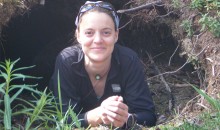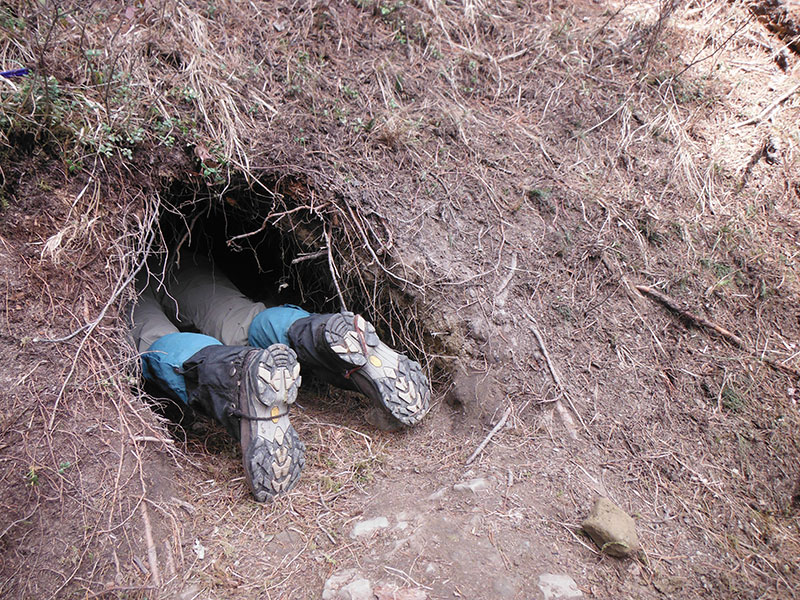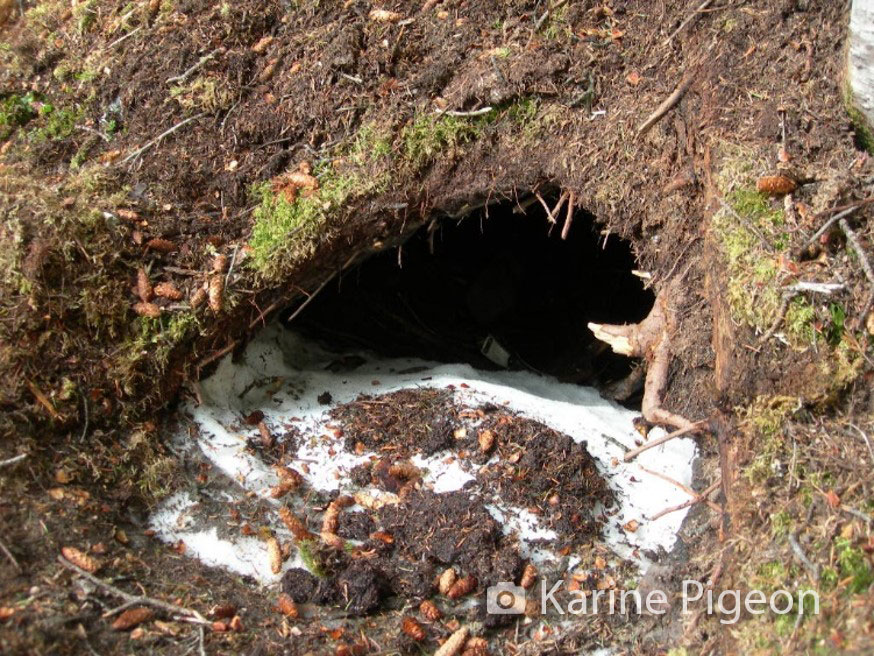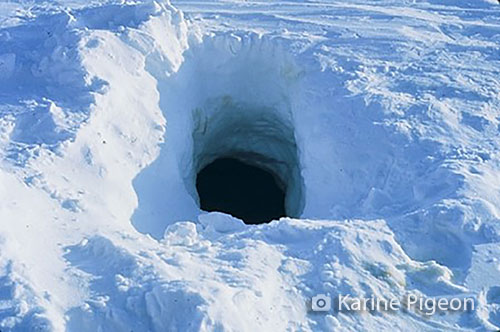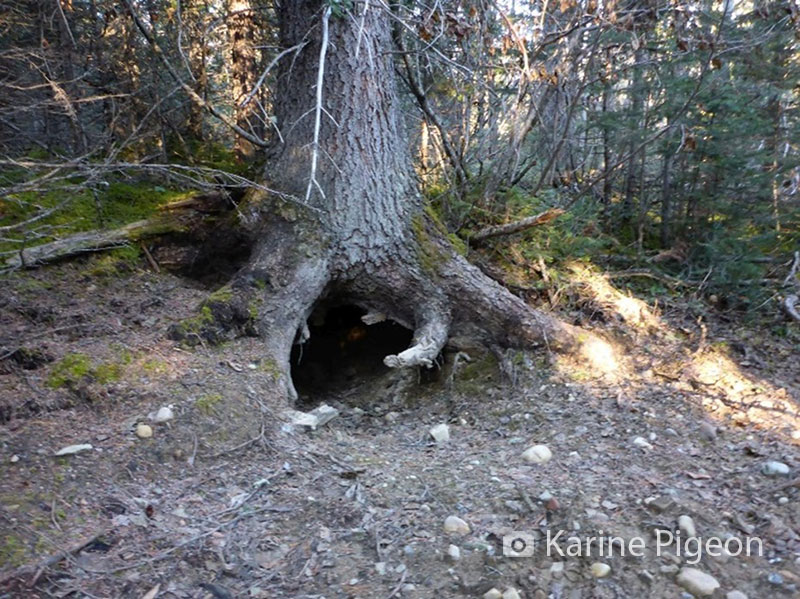Ben Williamson
(This post was updated on July 11; see below)
Dr. Karine Pigeon started studying grizzly bears as an MSc student and, eight years and a lot of hard work later, finished both her Master’s and PhD, joined the Caribou Program, and made impressive contributions to the conservation of two threatened species in Alberta.
Karine completed her PhD in April 2015 through her work with the Grizzly Bear Program, supervised by Dr. Steeve Côté of L’Université Laval. Her thesis answered key questions about how grizzly bear behaviour is affected by environmental conditions: where they forage, where they den, and what habitat they prefer.
The work is important for understanding the underlying biology of grizzly bears as well as providing practical guidance to land-use planners. For example, the den site selection research can be used by government and industry planners to minimize disturbances at den sites during activities such as winter forest harvesting.

The first paper to come out of her doctoral work was “Den selection by grizzly bears on a managed landscape.” It was published in the Journal of Mammalogy in June 2014, even before Karine’s thesis defense. Grizzly bears dig dens in the fall where they hibernate to save energy and where females can safely give birth. It’s a delicate time for them. If their den is disturbed, the vulnerable cubs can die, not to mention all the energy wasted making a new den.
Karine’s team created maps of grizzly bear home ranges overlaid with variables like food resources, anthropogenic disturbance, and land cover. They wanted to know if bears were picking den locations based on those variables, or if it’s just random.
They found that grizzly bears prefer high, dry conifer stands with lots of spring food. They avoid wetlands and saturated soils in general, probably because that provides poor insulation for the den. They don’t den close to well sites or roads, leading the authors to recommend limiting open roads in preferred denning habitat.
To get a more complete picture of how den sites are chosen, Karine integrated the large-scale remote sensing data with on-the-ground field observations. In March 2016, “Assessing Den Selection and Den Characteristics of Grizzly Bears” came out in The Journal of Wildlife Management.
Karine and her co-authors visited over a decade’s worth of grizzly bear dens in the Yellowhead and Grande Cache populations. By actually going to the dens, they could learn about den selection on a much finer scale. They thought there might be three main things that bears use to choose a den site: structural stability, nearby food, and how concealed the site is.
The researchers set about measuring things like the size of the dens, the type of soil they were dug out of, even the number of roots around them. Males and females dug dens that are about the same size, even though males can be much larger. Grizzly bears also weren’t picky about soil type, possibly because most soil types in the region are fine for dens.
A bigger factor for choosing a den site was spring food availability. Grizzly bears seem to prefer sites with lots of sweet-vetch, an important source of energy for grizzly bears when they come out of their dens. Grizzly bears also select sites with greater canopy cover, which might reduce the chances of disturbance by humans or other animals. Denser tree cover could also help shelter the dens from wind and cold temperatures, and make the dens a bit more stable.

April 2016 saw the publication of “Staying cool in a changing landscape: the influence of maximum daily ambient temperature on grizzly bear habitat selection” in Oecologia. Karine and her colleagues looked at how grizzly bears are balancing, on one hand, the need to forage as much as possible where the food is good, and on the other, the need to go somewhere cool when it’s too hot.
“Animals are constantly making trade-offs,” write the authors. They try to maximize their foraging efficiency by staying in places with the best food sources, but there are costs as well as benefits. Competition and food availability are big ones, but thermoregulation is also a consideration, and with average global temperatures expected to rise by at least 1.5 °C by the end of the century, the challenge of staying cool will only get bigger.
The general strategy of grizzly bears is to forage in open areas during the day, especially in early morning and late evening, and to rest under the forest canopy. They mainly spend time where the food is plentiful, and avoid human activity. The question is whether high temperatures will cause them to deviate from this strategy by going to shadier habitat at the cost of missing out on the best food sources.
The fRI Research Grizzly Bear Program has been fitting grizzly bears with radio-collars since 1999 to track where they roam. This tells us what habitat they like, where they linger, and what they avoid. Karine and her colleagues compared the bear location data with hourly temperature measurements and habitat maps developed with the GIS program. Putting it all together, they could figure out what kinds of habitats—conifer stands, shrublands, old cutblocks (lots of regrowth), and new cutblocks (minimal regrowth)—bears go to at different temperatures.
During the warmest part of the day, grizzly bears avoided new cutblocks and went to old cutblocks where there is more shade. This effect was a bit more pronounced in males than females, possibly because the larger males have a harder time staying cool. This shows that grizzly bears change their behaviour to suit the conditions, even when it affects their foraging efficiency. In the future, as climate change increases thermoregulation costs, bears might be more affected and have to further compromise their nutrition.
These contributions are just the start. Karine has more papers in preparation from her grizzly bear research, as well as her more recent Caribou Program projects. Check fRIresearch.ca to catch them when they come out.

Update: July 11 2016
The rumour that more papers were about to be published were true! On July 11, Karine’s final paper from her PhD thesis, “Drivers of hibernation: linking food and weather to denning behaviour of grizzly bears,” was published in Behavioral Ecology and Sociobiology.
Briefly, it found that increased berry availability in the fall delays grizzly bears from denning, and milder weather hastens the end of denning. Because of this, it is predicted that climate change will shorten the time grizzly bears spend in dens. Karine and her co-authors also found that denning behaviour is affected by the bear’s sex and reproductive status.







